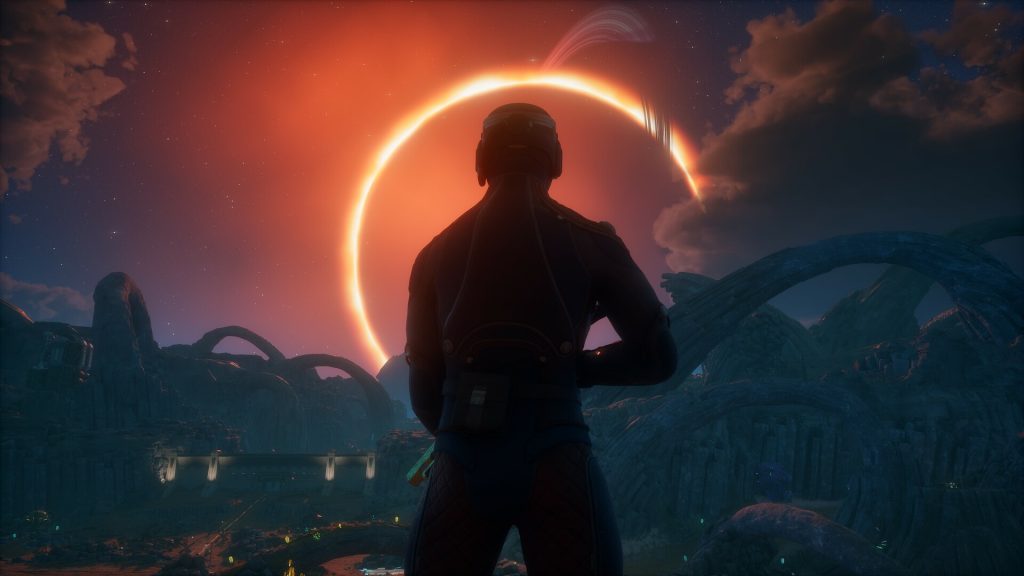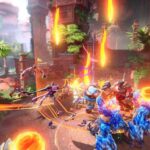The role-playing mechanics. The spirit of old school western rpgs permeates in small pockets through the first game, something some players appreciated (and some didn’t), even if some bemoaned the shorter length and budget constraints. Now, the sequel looks to expand upon that foundation in almost every way, from the enhanced role-playing depth, to a darker narrative with real stakes. If everything comes together as it’s being teased, The Outer Worlds 2 could be one of the year’s most memorable releases for fans of the genre.
If one were to peel back what makes any beloved RPG sparkle, at the beating heart would be the player-driven mechanics. But just like any healthy heart, these RPG elements have to be lean and purposeful. Its this focused approach that Outer Worlds adopted with the sequel. The role-playing is more meaningful and effective while being streamlined in several small areas, notably the omission of attributes. Your character is defined by a chosen background, a wealth of traits and flaws, and tagged skills. The hit of attributes going the way of the Dodo is softened by the far weightier skill point attributions. One skill point isn’t just a nudge forward; it can completely shift how a character handles conversations, combat, and exploration. I wasn’t happy when The Elder Scrolls progressively stripped away whole sets of skills and got rid of levitation after Morrowind, so I’m not going to pretend this tradeoff in The Outer Worlds 2 doesn’t leave me with a bit of uncertainty, but I’m also a big proponent of quality over quantity and that looks to be what the game is prioritizing.
Speaking of quantity, the sequel introduces more skill checks and environmental checks than before, weaving them seamlessly through dialogue and world design. This not only makes Arcadia more reactive but also tips it ever closer into the immersive sim category. Every situation has multiple solutions. One quest demonstrates just how creative and branching your options can be. The goal is to get across a tightly patrolled bridge. Okay, simple enough, however, the number of ways it can be overcome is dazzling. Talk your way through a guarded checkpoint using your Speech skill, or maybe you’re a stealthy rogue who wants to sneak past detection systems and patrol units. Acquire some nifty double jump boots? Well, mixing those with some poison-reduction equipment will get you through the swampy underside of the bridge. Want to go in Rambo-style? There’s plenty of heavy weaponry that’ll suit that task.

What really elevates the role-playing depth, though, are the expanded perks and flaws. Drawing inspiration from Fallout, the sequel boasts over 100 perks, many of them situational in nature. Flaws are also more diverse this time around, and often come with tradeoffs rather than outright handicaps. The “Overprepared” flaw, for instance, gives you larger magazine sizes but weakens your damage once those magazines are depleted. Others, like “Bad Knees,” speed up your movement at the expense of occasional cracking sounds breaking your stealth attempt. The “Foot in Mouth” flaw appeals to the high persuasion character in me with its timed dialogue choices. What’s more, failing to select an option selects for you or results in other unpredictable consequences.
The sequel has doubled down on the unpredictable creativity of its weapons and combat systems to reinforce those RPG elements. Gunplay feels snappier yet more weighty, with unique reload animations and quirks that give every firearm its own charm. Your bizarre arsenal doesn’t just feature standard and science weapons but for the first time, science armor and throwable gadgets. I particularly like the science grenades and can’t wait to use them to suspend foes in midair as often as I can.
Mobility has also been expanded. A new double-jump and parkour mantle system gives players more fluid ways to navigate vertical environments or, you know, just gain an edge in combat. For those who want more situational awareness, a third-person perspective can now be toggled, making battles feel less claustrophobic.
But it’s the wackiness of the core weapons where The Outer Worlds 2 finds its quirky niche in the RPG space. Take the “Armageddon,” a science weapon that launches a swarm of disembodied arms at enemies. Or the “Boarst Blaster,” which fires tumors that detonate on impact, leaving the player delicious Cystypig bits that heal you mid-fight. And then perhaps my favorite of the bunch, the “Pop-Up Gun”, which floods the battlefield with advertisements in an effort to distract enemies.

Melee users aren’t left out either. There’s a “Spectrum Dance Saber” that turns combat into a rhythm-based dance of sorts, rewarding players for swinging in time with a beat. The list of creative weapons goes on and on and it’ll be just as fun finding new ones as it’ll be using them on those poor unsuspecting souls of Arcadia.
Companions have always been a defining fixture of RPGs and Outer Worlds 2 is continuing that. Players will be able to recruit six companions, each with their own personality, allegiances, and moral outlooks. They aren’t just along for the ride; they have strong feelings about the choices you make in Arcadia, and they’re not afraid to voice them.
Companions seem way more reactive to the world and your choices within it than last time. We’ve heard some examples of what companions demand and insist upon, but the one that sticks out to me is an appeal to obliterate one of the system’s settlements. Yeah, they can get pretty demanding, scarily so. What’s more, turning them down will often leave them angry, sometimes leaving the party altogether.
Oh, and for the first time, players can sacrifice companions outright. Sometimes this takes the form of a quest, such as sacrificing someone to access an area. I’m a sucker for this kind of player freedom, especially when it has to do with core content and key characters.

Just like in the original game, your companions can develop their own personal arcs while exploring the galaxy, and those stories can unfold in multiple ways depending on your choices. Maybe things go well for them, or maybe they don’t – the universe can be unpredictable like that. And while you can certainly influence what happens to them, your own journey remains focused entirely on shaping the fate of the crew and the world around you.
The Outer Worlds 2 retains the first game’s setting and injects an extra dose of grandiosity. The setup is immediately more ambitious: as an Earth Directorate agent, you must reign in the colony of Arcadia and keep it from more or less eating itself. First, there’s the factional war tearing Arcadia apart. Then, some odd spacial rifts start popping up, escalating things even more as colonies get separated from earth. Navigating the factional dispute while exploring the anomalous rifts are your duty as an agent of the Earth Directorate.
Each of the three factions has their own distinctive philosophy, aesthetic, and brand of propaganda that sets them apart. The Protectorate faction prioritizes stability and loyalty, being the military regime that it loves to remind folks it is. Meanwhile, players of the first game will no doubt recognize Auntie’s Choice, a merger between Spacer’s Choice and, you guessed it, Auntie Cleo. Well, all that sloganeering from the first game has gone galactic, and quite sinister, as Auntie’s Choice functions as the consumerist corporate boot on the people of Arcadia.
Factions aren’t merely static window dressing for the world though, they evolve and interact with the player in unique and fun ways. For example, each faction has their own dedicated radio station spewing a unique brand of propaganda between the 20 or so station-specific songs. The radio even comments on the player’s exploits in real-time, adding that extra juicy layer of reactivity to everything you do.
Factions will occasionally swap control of settlements as they vie for power, altering the look of each locale. Auntie’s Choice likes to slap their mascots on windows, light-posts, you name it, while the Earth Protectorate prefers to keep things uniform and orderly.
While the tone is darker and the stakes are higher, The Outer Worlds 2 still delivers the quirky setting of the first game. Combined with the overarching mystery of the rifts and the tug-of-war between ideologies, the sequel is promising a more engaging and high-stakes narrative filled with the deep role-playing systems fans crave.
Note: The views expressed in this article are those of the author and do not necessarily represent the views of, and should not be attributed to, GamingBolt as an organization.



